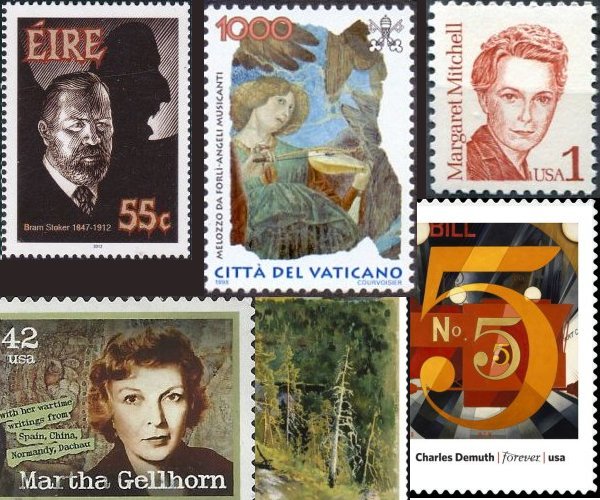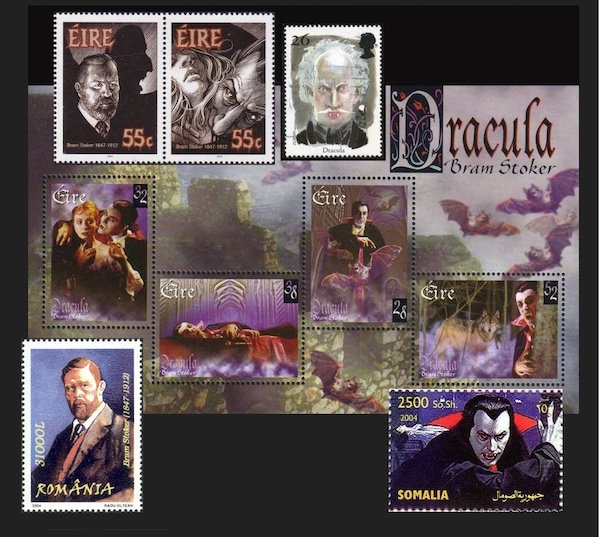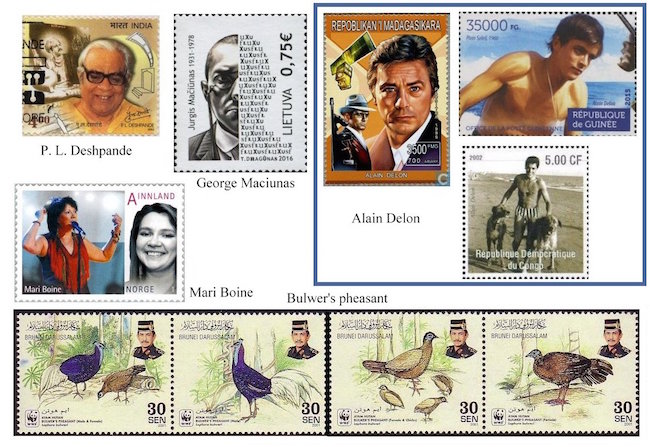The Arts on Stamps of the World — November 8
An Arts Fuse regular feature: the arts on stamps of the world.

By Doug Briscoe
It was a dark and stormy night. It’s a stretch, but I couldn’t resist. November 8 is the birthday of both Bram Stoker and the son of Edward Bulwer-Litton, whose opening line for his novel Paul Clifford seems appropriate for the creator of Dracula. The son, by the way, Robert Bulwer-Lytton (8 November 1831 – 24 November 1891), would not at all be out of place here on AoSotW (if he had a stamp) as, besides his vocation as a diplomat and statesman, he wrote poetry, which was much admired in the day. Indeed, Oscar Wilde dedicated Lady Windermere’s Fan to him. Besides Bram Stoker, we also celebrate today another novelist, Margaret Mitchell. A third, Kazuo Ishiguro (born 8 November 1954), seems to have no stamp as of yet, though with his new Nobel Prize it shouldn’t be long now.

Bram Stoker (8 November 1847 – 20 April 1912) was born in Dublin (a Protestant) and became a theater critic for the Dublin Evening Mail. (The co-owner of the paper was Sheridan Le Fanu, another writer of Gothic horror stories.) Stoker wrote a favorable review of the Hamlet of Sir Henry Irving, and the great actor invited him to dinner, leading to a long friendship and professional association, as Stoker later became Irving’s personal assistant and manager of Irving’s Lyceum Theatre in London. There’s another Oscar Wilde connection here: Stoker married Florence Balcombe, whose hand had once been sought by Wilde. Stoker and Wilde had known each other since their school days. Stoker accompanied Irving on his travels, including at least one visit to America, where he met one of his favorite poets, Walt Whitman. When F. W. Murnau made his famous film Nosferatu in 1922, Stoker’s widow Florence sued and insisted that all prints and negatives of the film be destroyed. She won the case three years later, but luckily for posterity one copy survived. (She approved Todd Browning’s version before her death in 1937.) Dracula (1897) has inspired three ballets and two operas, all of them less than twenty years old! For the author’s centenary in 2012, his native Ireland issued a pair of stamps, one a portrait, the other a representation of Stoker’s most famous creation doing what he does best. Next to them is a stamp from a British set of “stories and legends”, which, by the way, faithfully reproduces Stoker’s description of the Count when Jonathan Harker first meets him as “a tall old man” with a “long white moustache.” At bottom we have another Stoker from Romania (think about it) and a Dracula from Somalia.
The history books record no mention of Italian painter and architect Melozzo da Forlì (c. 1438 – 8 November 1494) before 1460. A few years later Melozzo and Antoniazzo Romano painted frescoes for the Basilica dei Santi Apostoli in Rome, and it is these that are seen on the strip of three stamps from San Marino, the set of six from the Vatican, and the single postal tax stamp from Costa Rica. After returning to Rome from several years in Urbino, where he had met Piero della Francesca, Melozzo painted the beautiful Sixtus IV Appointing Platina as Librarian of the Vatican Library (not on stamps). When that pontiff founded the Academy of St Luke in 1478, Melozzo was one of the original members. On the pope’s death, Melozzo went to Loreto for five years. There he painted the architectural fresco in a cupola of the Basilica della Santa Casa. He returned once more to Rome in 1489 but died in his hometown of Forlì five year later. for the paintings are notable for the use of foreshortening.
Finnish painter Eero Järnefelt (8 November 1863 – 15 November 1937) was a brother of the composer and conductor Armas Järnefelt and of Aino Järnefelt, who married Jean Sibelius. Two other brothers, Kasper and Arvid, were a literary critic and a judge and writer respectively. Eero, who was born Erik, studied art privately, at Helsinki’s Academy of Fine Arts, at St Petersburg, and at Paris. Jules Bastien-Lepage, whose birthday we acknowledged here a week ago, was a major influence. Järnefelt discovered the area around Lake Pielinen (since 1991 Koli National Park) when he was nearly thirty and fell in love with it, returning again and again, painting what he saw. An example is shown on a double issue of 1993: Autumn Landscape of Lake Pielinen (1899). Two more Järnefelt paintings were reproduced on stamps in 2013: Forest Landscape (1895) and the troubling Under the Yoke (Burning the Brushwood, 1893). A much more pleasant picture of childhood is seen in Portrait of the Artist’s Son (1887).

Another painter of the north was the French Canadian Clarence Gagnon (8 November 1881 – 5 January 1942), and he, too, specialized in landscapes, his region of preference being the Laurentians and the Charlevoix region of eastern Quebec. Gagnon studied in Montreal and Paris, where he remained about five years. He returned to live in France from 1924 to 1936. Gagnon was also an engraver and illustrator who provided the images for Louis Hémon’s novel Maria Chapdelaine. The stamp from 1974 shows his Village in the Laurentian Mountains.
Our fourth consecutive painter is the American watercolorist Charles Demuth (November 8, 1883 – October 23, 1935), who pronounced his name DEE-muth, thus earning the nickname “Deem”. He was born in Lancaster, Pennsylvania and lived there all his life, in a house he shared with his mother and that is now a museum. While attending Pennsylvania Academy of Fine Arts he met William Carlos William and formed a lifelong friendship. Indeed, Demuth’s most famous picture, I Saw the Figure 5 in Gold (1928), was directly inspired by Williams’s poem “The Great Figure”. It was selected for the Demuth stamp on a 2013 sheet of stamps reflecting American modern art.
Like Charles Demuth, Margaret Mitchell (November 8, 1900 – August 16, 1949) lived in her birthplace, which in her case was Atlanta, Georgia, all her life, though she did attend Smith College. She started writing stories in childhood and wrote articles for the Atlanta Journal, but only from 1922 to 1926. She wrote over 200 pieces for the journal, but only one novel, Gone with the Wind, which won the National Book Award in 1936 and the Pulitzer Prize for Fiction in 1937. Both the author and her book have been recognized on US stamps. Margaret Mitchell was killed by an automobile at age 48.
From a 2008 set of stamps honoring American journalists comes one for Martha Gellhorn (November 8, 1908 – February 15, 1998). Gellhorn is best known for her war correspondence and also wrote novels and books of travel. She wrote for the New Republic in 1927 and for UP in Paris for two years. On her return to the US she worked for the Federal Emergency Relief Administration, work that resulted in a collection of short stories called The Trouble I’ve Seen (1936). Gellhorn’s first war was the one in Spain, where she was accompanied by future husband Ernest Hemingway. She was in Czechoslovakia in 1938 and covered World War II from Finland, Hong Kong, Burma, Singapore, and Great Britain. She stowed away aboard ship and was the only woman to land in Normandy on D-Day. By this time she was married to Hemingway, but their union ended with the war. (She had also had an affair with 82nd Airborne commander General James M. Gavin.) In later years Gellhorn covered Vietnam, Arab-Israeli conflicts of the 60s and 70s, and finally, just before her retirement, the US invasion of Panama. Ill with cancer and nearly blind, she committed suicide in London at age 89. Like Margaret Mitchell, she authored a single novel, The Lowest Trees Have Tops (1967), about McCarthyism; but there are two volumes of short novels and novellas, and she co-wrote a play in 1948.

Hermann Zapf (November 8, 1918 – June 4, 2015) is best known for his work as a typeface designer who created the German typefaces Palatino, Optima, and Zapfino, but he was also a calligrapher and stamp designer. In the early 1950s he designed three sets of German stamps honoring humanitarians, and I present the first group from 1951. The subjects are St. Vincent de Paul, Friedrich von Bodelschwingh, who founded a number of charitable institutions, the Swedish nurse Elsa Brändström, and the Swiss educational reformer Johann Heinrich Pestalozzi.
The Marathi writer, actor, composer, and musician Purushottam Lakshman Deshpande (8 November 1919 – 12 June 2000) was popularly known as Pu La or as P. L. Deshpande. His grandfather was a poet who had translated Rabindranath Tagore’s collection Gitanjali into Marathi. Pu La was an accomplished Hindustani musician who acted on stage and in film, directed, and wrote screenplays, but he is best remembered for his humorous writing.
Lithuanian-born American experimental artist Jurgis or George Maciunas (originally Mačiūnas; 1931 – May 9, 1978) was born to an architect father and a dancer who performed with the Lithuanian National Opera and was later personal assistant to Alexander Kerensky. The Mačiūnas family fled the advancing Russian Army in 1944 and wound up four years later living on Long Island. Young George studied art, graphic design, architecture, and musicology, a sort of perpetual student who was at one institution of learning or another until he was nearly thirty. But soon after that he became a founding member of and driving force behind the avant-garde artistic community he dubbed Fluxus. The inspiration for this group was to a large extent composer John Cage. Maciunas himself wrote music in addition to his work in graphics and other arts. Always troubled with ill health, he died on cancer in a Boston hospital at 46. The Lithuanian stamp was just issued last year.

French actor Alain Delon (born 8 November 1935) celebrates his 82nd birthday today. Born in a suburb of Paris, he had an unsettled childhood (his parents divorced when he was 4) and was always getting into trouble, even being dishonorably discharged from the French Navy. He was discovered by a scout for David O. Selznick while visiting Cannes but began his acting career in French films. This was in 1957. The next year he played opposite Romy Schneider9/23, with whom he had a romantic liaison lasting five years. By the early 60s Delon had had a string of successes in Europe and hoped to break into Hollywood but was never a hit in the US. Besides his popularity in Europe, though, he was a huge star in Japan in the 60s.
As conscious as we are of prejudice and discrimination, I’ll wager few of us know the Sami people (Laplanders) have traditionally been treated as second-class citizens by their fellow Norwegians. Sami singer/songwriter Mari Boine (born 8 November 1956) has often addressed this social wrong, as well as the atmosphere of her beloved native region, in her songs. She had a hit with her 1989 album Gula Gula. She has been a professor of musicology at Nesna University College since 2008.
Having mentioned the Bulwer-Litton family at the outset, I thought I’d follow through with a tangentially related set of stamps. These are a group from Brunei highlighting Bulwer’s pheasant (Lophura bulweri), named in 1874 for the novelist’s nephew Sir Henry Ernest Gascoyne Bulwer, Governor of Labuan from 1871 to 1875, who presented the specimen to the British Museum. The bird is endemic to the forests of Borneo. Anything to get more stamps into the spotlight.
A graduate of the University of Massachusetts with a B.A. in English, Doug Briscoe worked in Boston classical music radio, at WCRB, WGBH, and WBUR, for about 25 years, beginning in 1977. He has the curious distinction of having succeeded Robert J. Lurtsema twice, first as host of WGBH’s weekday morning classical music program in 1993, then as host of the weekend program when Robert J.’s health failed in 2000. Doug also wrote liner notes for several of the late Gunther Schuller’s GM Recordings releases as well as program notes for the Boston Classical Orchestra. For the past few years he’s been posting a Facebook “blog” of classical music on stamps of the world, which has now been expanded to encompass all the arts for The Arts Fuse.
